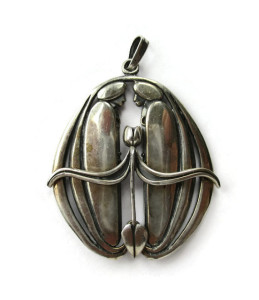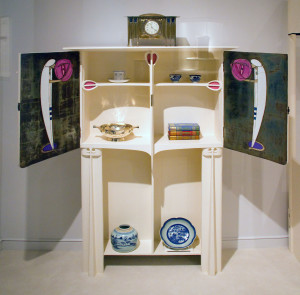Charles Rennie Mackintosh (1868-1928) is the most iconic of all Scottish Arts and Crafts designers. Glasgow-born and based Mackintosh was a talented architect, furniture designer, artist, and more. His works have inspired a range of replicas and items inspired by his designs, and these are fondly known as ‘Mockintoshes‘ (I’m a sucker for a bit of word play).
I recently acquired a piece of silver jewellery, a pendant, in a style that I thought was almost certainly Mackintosh, but with a motif I didn’t recognise. The pendant has two turbaned figures with what look like long capes facing each other. They are so stylised that it is easy to look at the design and not see the figures immediately.

Charles Rennie Mackintosh-inspired sterling silver pendant by Malcolm Gray of Ortak. For sale in my Etsy shop: click on photo for details. (NOW SOLD).
I wondered what the inspiration for the piece was. Some internet truffling was in order. Luckily for me I hit pay dirt in the first place I looked: the Wikipedia page on Rennie Mackintosh:

Cabinet designed by Charles Rennie Mackintosh, in the collections of the Royal Ontario Museum, Canada. Photo by Tony Hisgett.
Going to the Royal Ontario Museum website, I found that the cabinet was designed by Rennie Mackintosh in 1902, and made by Francis Smith and Son in Glasgow that same year. The cabinet is in white painted oak, and the insides of the doors are lined with silver foil inlaid with a design in coloured glass of a woman holding a stylised rose in the design known as the Glasgow Rose. The Museum acquired its example in 1983-4.
More truffling showed that Mackintosh’s original design for the cabinet (accession no GLAHA 41118) is held by the Hunterian Museum and Art Gallery at the University of Glasgow. The Hunterian holds a huge collection of material by and related to Mackintosh. The pair of cabinets were designed for Mrs Rowat (the mother-in-law of Mackintosh’s friend and mentor, Francis Henry Newbery) for the living room of her house at 14 Kingsborough Gardens, Glasgow.
Mackintosh had a duplicate pair made for his own home in Glasgow, and this pair is now on display in ‘The Mackintosh House’ in the Hunterian Museum (accession nos GLAHA 41221 and 41222), where they can be seen flanking one of the fireplaces.
As well as featuring the Glasgow Rose, the design also features the heart-shaped leaf motif known as the ‘cicely leaf’ or ‘cecily leaf’. Both motifs were used by Mackintosh and so are often found in Mockintoshes. I’ve written a short blog post on the cicely leaf motif here.